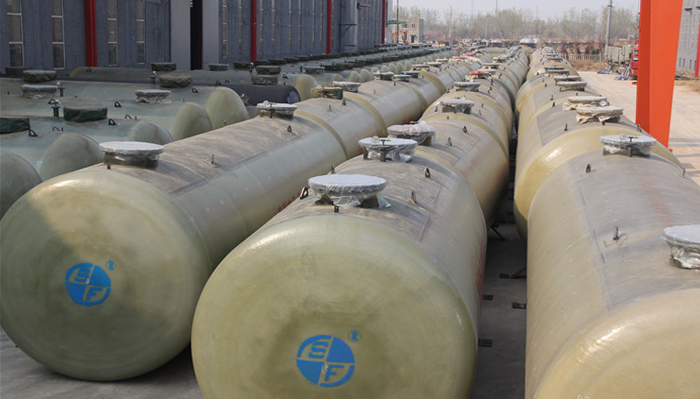Product Category
Common problems of double layer oil tank
Date: Jan 08, 2020

Double layer oil tank is developed on the basis of single layer oil tank. With the development of modern society and economy, it also accelerates the emergence of gas station problems to a certain extent. With the severity of environmental pollution, the traditional single-layer tank has violated the requirements of the harmonious development of economic environment.
Double layer oil tank has the characteristics of safety, environmental protection and durability. Due to the use of thickened steel plate and glass fiber reinforced plastic layer, the service life of oil tank is longer. This kind of oil tank can be tested in time to ensure that the leakage can be found in time without polluting the soil and groundwater. In addition, this kind of oil storage tank can also be buried in the ground independently, without the need to build additional tank pool, which can reduce the comprehensive cost.
Leakage test content of double layer oil tank:
1. Penetration test of underground oil tank: the equipment welds are inspected by kerosene penetration method. The equipment welds are coated with chalk slurry outside and kerosene inside after drying. After half an hour of inspection, it is qualified if there is no kerosene leakage spot.
2. Air tightness test of underground oil tank: the equipment shall be subject to air tightness test to make the pressure rise slowly. After reaching the specified test pressure, the pressure shall be maintained for 10 minutes, and then the pressure shall be reduced to the design pressure. The welds and connecting parts shall be coated with soapy water, and it is qualified if there is no bubble blowing.
3. Gas tightness test of oil tank: the equipment shall be subject to gas tightness test to make the pressure rise slowly. After reaching the specified test pressure, the pressure shall be maintained for 10 minutes, then the pressure shall be reduced to the design pressure. The welds and connecting parts shall be coated with soap water, and it is qualified if no bubble blowing is found. 4. Water leakage test of underground oil tank: the surface of the equipment shall be cleaned and fully dried. After water filling, it shall be determined according to the time required for observation and inspection. During the test, it is qualified if no
4. Water leakage test of underground oil tank: the surface of the equipment shall be cleaned and fully dried. After water filling, it shall be determined according to the time required for observation and inspection. During the test, it is qualified if no
leakage is found in the weld.
Troubleshooting of double layer oil tank:
1. If the drain valve of double-layer oil tank fails, the mechanic shall immediately put on the blind plate and report the situation to the superior in time.
2. Fire and explosion: in case of such an accident, the relevant operators shall immediately stop the drainage operation, close the gate valve of the oil tank, send a fire alarm signal and put out the fire.
3. Accidental poisoning of staff: in case of poisoning, the staff shall immediately report to the manager of the oil depot, and transfer the poisoned personnel to a safe area; carry out appropriate rescue according to the poisoning situation, and send to the hospital for first aid as soon as possible in case of serious poisoning.
Therefore, for the sake of safety, environmental protection and waste of resources, double-layer oil tank leakage prevention is an indispensable part. When the double-layer oil tank is used in the initial stage, it is a key point to check the leakproofness of the oil tank. When the oil tank is used for the first time, leakage test shall be carried out.
In the later use, it is also an important work to check the leakproofness of the oil tank regularly. In fact, the leak test of the oil tank is very simple. As long as some commonly used technologies are tested and observed carefully, the leak resistance of the oil tank can be simply judged.
Double layer oil tank has the characteristics of safety, environmental protection and durability. Due to the use of thickened steel plate and glass fiber reinforced plastic layer, the service life of oil tank is longer. This kind of oil tank can be tested in time to ensure that the leakage can be found in time without polluting the soil and groundwater. In addition, this kind of oil storage tank can also be buried in the ground independently, without the need to build additional tank pool, which can reduce the comprehensive cost.
Leakage test content of double layer oil tank:
1. Penetration test of underground oil tank: the equipment welds are inspected by kerosene penetration method. The equipment welds are coated with chalk slurry outside and kerosene inside after drying. After half an hour of inspection, it is qualified if there is no kerosene leakage spot.
2. Air tightness test of underground oil tank: the equipment shall be subject to air tightness test to make the pressure rise slowly. After reaching the specified test pressure, the pressure shall be maintained for 10 minutes, and then the pressure shall be reduced to the design pressure. The welds and connecting parts shall be coated with soapy water, and it is qualified if there is no bubble blowing.
3. Gas tightness test of oil tank: the equipment shall be subject to gas tightness test to make the pressure rise slowly. After reaching the specified test pressure, the pressure shall be maintained for 10 minutes, then the pressure shall be reduced to the design pressure. The welds and connecting parts shall be coated with soap water, and it is qualified if no bubble blowing is found.

leakage is found in the weld.
Troubleshooting of double layer oil tank:
1. If the drain valve of double-layer oil tank fails, the mechanic shall immediately put on the blind plate and report the situation to the superior in time.
2. Fire and explosion: in case of such an accident, the relevant operators shall immediately stop the drainage operation, close the gate valve of the oil tank, send a fire alarm signal and put out the fire.
3. Accidental poisoning of staff: in case of poisoning, the staff shall immediately report to the manager of the oil depot, and transfer the poisoned personnel to a safe area; carry out appropriate rescue according to the poisoning situation, and send to the hospital for first aid as soon as possible in case of serious poisoning.
Therefore, for the sake of safety, environmental protection and waste of resources, double-layer oil tank leakage prevention is an indispensable part. When the double-layer oil tank is used in the initial stage, it is a key point to check the leakproofness of the oil tank. When the oil tank is used for the first time, leakage test shall be carried out.
In the later use, it is also an important work to check the leakproofness of the oil tank regularly. In fact, the leak test of the oil tank is very simple. As long as some commonly used technologies are tested and observed carefully, the leak resistance of the oil tank can be simply judged.
Last article:
Next article:
Send Your Inquiry
We not only provide a good product, but also provide high quality service. If you are interested in our products,
you can contact us in the following ways.
you can contact us in the following ways.















































































































